April 4, 2014
Air Date: April 4, 2014
FULL SHOW
SEGMENTS
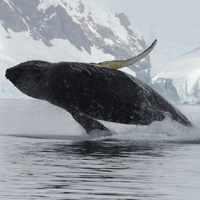
International Court Saves Whales
View the page for this story
Japan has been hunting whales under the guise of science since a ban nearly thirty years ago. Now Duke university marine biologist Andy Read tells host Steve Curwood that a new ruling from the International Court of Justice could put an end to Japanese whaling. (06:40)

Big El Niño Coming?
View the page for this story
Conditions in the western Pacific Ocean point to an unusually intense El Niño weather pattern for 2014/15. Climate scientist Kevin Trenberth tells host Steve Curwood that the last extreme El Niño event in 1997/98 coincided with drought in Australia and Africa, severe ice storms in Northeastern North America, and the Pacific Ocean’s most active hurricane year on record. (06:55)
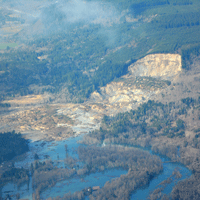
Washington State Landslide -- Living with Risk
View the page for this story
The danger from landslides was well-known in Washington state, but that didn’t stop local officials from letting people build in the danger zone. Ashley Ahearn reports on the geology and planning from Seattle and discusses why people live in harm’s way with host, Steve Curwood. (10:00)

Exxon: The Economy Is Stronger Than the Environment
View the page for this story
ExxonMobil has responded to a shareholders’ resolution with a detailed analysis of climate risks to the company's business future. The report acknowledges the seriousness of global warming, yet Exxon VP Ken Cohen tells host Steve Curwood that he does not expect carbon regulation to disrupt the company's core businesses. (07:15)

Beyond the Headlines
View the page for this story
We take a peak beyond the news headlines of with Peter Dykstra, publisher of Environmental Health News. This week, he and host Steve Curwood discuss how art helps document air pollution and a threat to traditional baseball bats. (04:00)
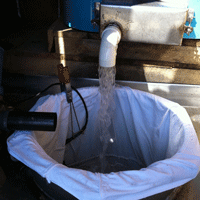
Maple Syrup and Climate Change
View the page for this story
Federal climate models predict that the Northeast U.S. will lose most of its maples by next century. But Julie Grant of the Allegheny Front reports that many maple sugar producers aren't worried; they say times are as sweet as their syrup. (06:00)

UN Climate Change Reports As Haiku
View the page for this story
The reports of the UN's Panel on Climate Change are critically important but notoriously dense. IPCC scientist Gregory Johnson tells host Steve Curwood about his personal project to write haiku poems to make the reports more understandable. (06:05)
Show Credits and Funders
Show Transcript
HOST: STEVE CURWOOD
GUESTS: Andy Read, Kevin Trenberth, Ken Cohen, Gregory Johnson
REPORTERS: Ashley Ahearn, Julie Grant, Peter Dykstra
[THEME]
CURWOOD: From Public Radio International, this is Living on Earth.
[THEME]
CURWOOD: I’m Steve Curwood. The International Court of Justice has ruled that Japan must stop all whaling off Antarctica. It's a ruling scientists say will help species hunted to near-extinction bounce back.
READ: Overall, one would say the populations of whales are doing reasonably well. They're recovering where they're provided adequate protection, and we are hoping that the court decision will be one more step in the recovery of whale populations in the Southern Ocean and elsewhere in the world's oceans.
CURWOOD: Also, the National Forest Service says climate change ultimately threatens sugar maples, but some maple syrup producers don't buy it.
BLOCHER: Oh, you hear about that all the time. And the global warming. But I think the sugar maple is a very hardy tree, and very adaptable. So I think under slight changes and so forth, it will adapt.
CURWOOD: That and more this week on Living on Earth. Stick around.
International Court Saves Whales
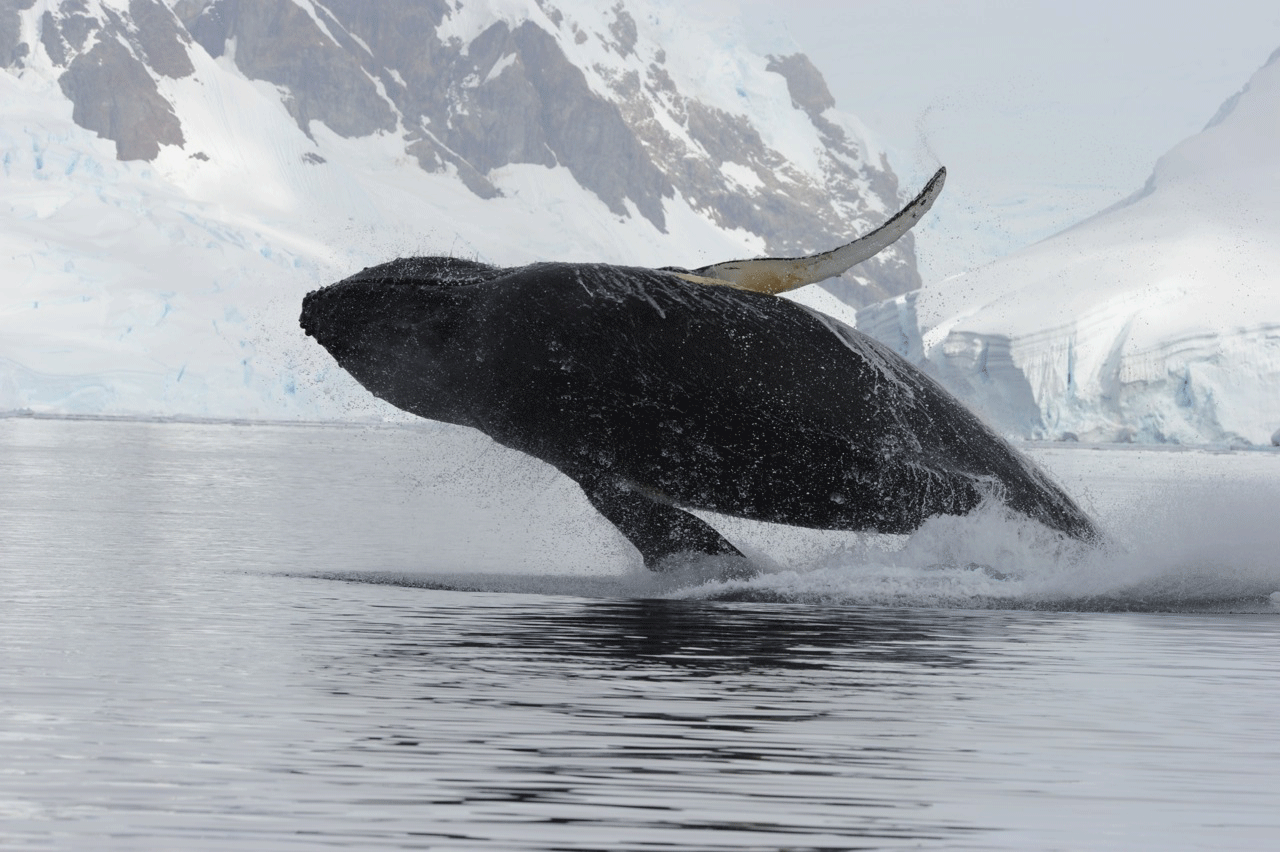
Humpback whale breaching in Wilhelmina Bay, Western Antarctic Peninsula. (photo: Dr. Ari Friedlaender, Oregon State University.)
CURWOOD: From the Jennifer and Ted Stanley Studios in Boston and PRI, this is Living on Earth. I’m Steve Curwood. There is good news this week for whales, especially those in the seas off Antarctica. The International Court of Justice has ordered Japan to stop what it found to be commercial whaling under the guise of scientific research. Though Japan signed on to the International Whaling Commission ban nearly thirty years ago, it kept on hunting. In 2010 Australia filed charges at the International Court, alleging Japan was in gross violation of the ban. For some analysis we called up Andy Read, Professor of Marine Biology at Duke University. He’s a former member of the science committee of the International Whaling Commission, and joins us now from North Carolina. Welcome to Living on Earth, Andy.
READ: It's my pleasure, thanks for having me.
CURWOOD: So what do you make of this news, the court decision? How big of a deal is this?
READ: It’s a pretty important decision. It’s a very clear ruling from the International Court that Japan has to cease and desist its Antarctic whaling program. Those of us have who have been involved in this issue for a long time were looking for clarity from the court, and we got it. It will stop immediately, any research whaling the Japanese government had anticipating conducting, and it leaves open a lot of questions what Japan will do. They have, in the past, threatened to leave the International Whaling Commission and to operate outside it. Whether or not they choose to do so, we’ll find out in the coming months and perhaps years. But it’s a clear and decisive step forward in terms of the management of whales in the Antarctic.
CURWOOD: So give us a little history lesson here, Professor. How were the Japanese able to continue whaling after the 1986 whaling ban went into effect?
READ: There are two routes to continue whaling. One is to file an objection to the moratorium, as you indicated it came into place, 1985, 1986. And several countries filed objections to that change, including Iceland and Norway, which continue to hunt whales commercially today. Japan withdrew its objection to that change under US pressure, and so was no longer about to engage in commercial whaling. But there is a provision within the convention that allows countries who are members of the International Whaling Commission to kill whales for the purposes of scientific research. The term ‘scientific research’ is not ever defined in the convention itself, but Japan engaged in a very large-scale, two large-scale projects actually, one of in the north Pacific and one in the Antarctic in which they killed more than 10,000 whales over the last couple of decades. The killing of those whales, was, according to the government of Japan, for the purposes of scientific research, but the meat that was generated from killing those whales was sold on the market in Japan. And so many of us, many independent observers, have argued that this is commercial whaling under the guise of science rather than a true scientific research program, and the court agreed with us in its decision.

Antarctic minke whale in Wilhelmina Bay, Western Antarctic Peninsula. Researchers use the notches in the trailing edge of the dorsal fin to identify the whale and to track it’s movements over time using photographic identification techniques. (photo: Dr. Ari Friedlaender, Oregon State University.)
CURWOOD: Now this ruling only applies to the Southern Ocean. What about Japanese whaling in the northern Pacific?
READ: Right. You’re correct, the ruling does not apply to the north Pacific. I think most of us believe that the precedent is strong enough that Japan will also stop its north Pacific program, but that’s not what the legal case says, so it’s possible that Japan will continue to take whales, especially permit catches in the north Pacific, although it seems unlikely to me they’d continue to do that.
CURWOOD: Now, what were the kinds of whales the Japanese where hunting?
READ: Three species of whales were listed under the Japanese Antarctic research program. Mostly Minke whales, the quota of Minke whales, the smallest of the baleen whales taken was about 850 a year. There were two other species, larger species, Fin whales and Humpback whales, and those three species were all listed under the program, although only Minke whales and Fin whales were taken. Japan never actually killed any Humpback whales as part of its research program.
CURWOOD: Now, what about Norway and Iceland where whaling is still practiced? How do those countries compare to Japan in terms of their whaling haul.
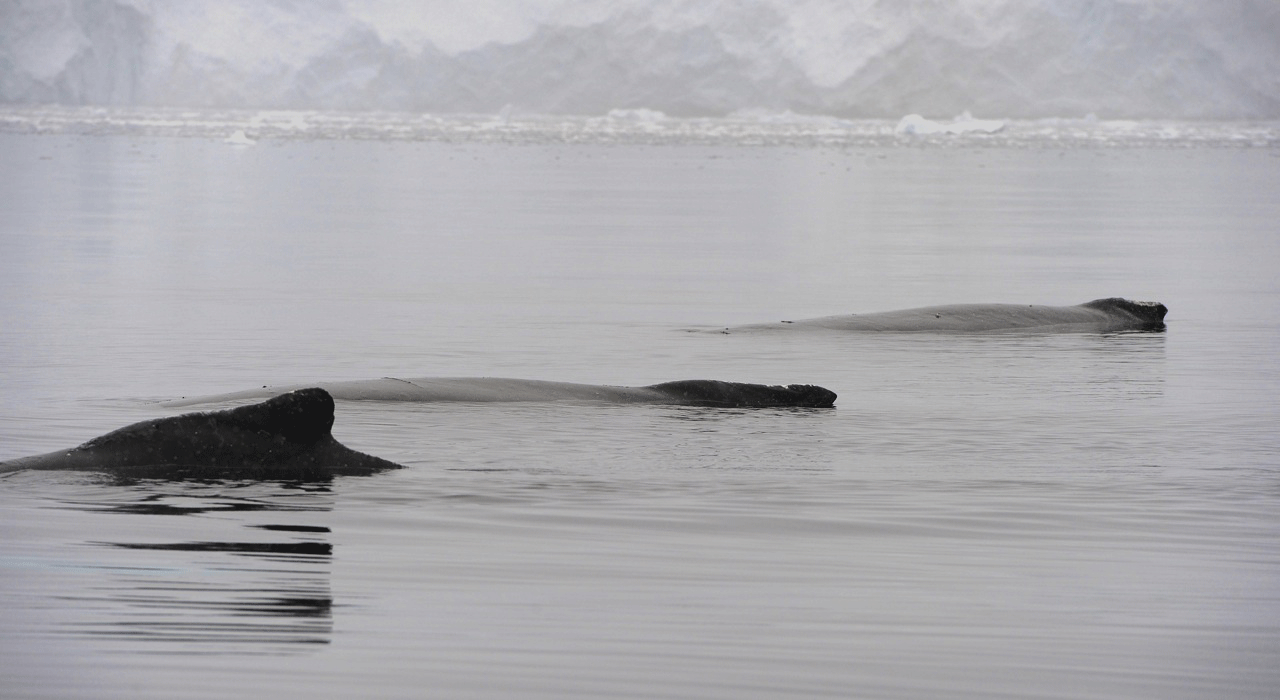
Trio of humpback whales resting at the surface in Wilhelmina Bay, Western Antarctic Peninsula. (photo: Dr. Ari Friedlaender, Oregon State University.)
READ: The numbers of whales taken by both Norway and Iceland are smaller than the number of whales taken by the Japanese programs. They’ve focused mostly on Minke whales, the smallest baleen whale, and the species for which the meat is most highly prized. But it’s possible those numbers could increase if Norway and Iceland decide to try and fill the Japanese market with products from their hunts.
CURWOOD: What kind of legal pressure if any does this put on Norway and Iceland to get out of the whaling business as well?
READ: None really. They have a legal right to conduct whaling under the convention. They filed objections to the moratorium when it came into place in 1985, 1986. And so their legal position is clear. And unless they decide, as a matter of either domestic pressure or international pressure to stop whaling, they can continue to harvest whales commercially.
CURWOOD: What other potential ripple effects are there here from this decision?
READ: We know that the Convention for the Regulation of Whaling only pertains to the great whales - to the large baleen whales and sperm whales, and one or two others. The smaller cetaceans, the dolphins and porpoises, are not covered. And we know when the moratorium first came into place in 1985, 1986, the numbers of those animals, the smaller dolphins and porpoises taken in Japanese fisheries went up considerably. So it’s possible that we’ll see an increase in the numbers of those animals harvested, both in the harpoon fishery and the drive fishery. The drive fishery is the fishery that was portrayed in the movie The Cove. And there’s considerable conservation concern about the status of dolphins and porpoises taken in those fisheries, so that could be an adverse consequence of the ruling.
CURWOOD: So, Andy, in general, how are whales doing around the world these days?
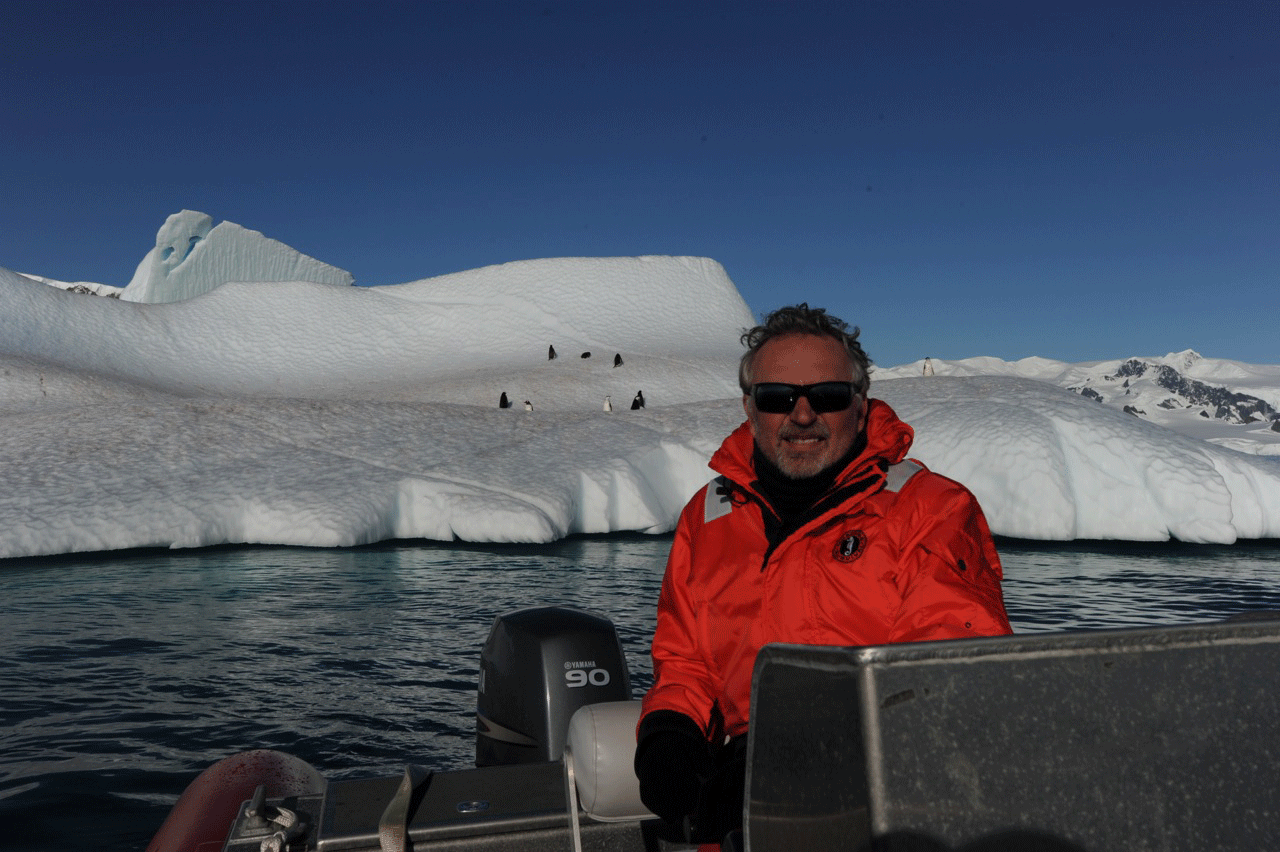
Andy Read, hard at work in the Antarctic (photo: Dr. Ari Friedlaender, Oregon State University.)
READ: It depends on the species, and it depends on the population. Many populations of whales are recovering from past overharvest, past uncontrolled harvest. So in the Southern Ocean we’re seeing populations of Blue whales and Humpback whales recovering rapidly, although they’re still very small compared to what they were before the harvest started. Other whale populations are not doing so well. North Atlantic and North Pacific Right whales are still tiny populations, maybe 50 north Pacific Right whales and perhaps 500 North Atlantic Right whales. But overall, one would say the populations of whales are doing reasonably well. They're recovering where they're provided adequate protection, and we are hoping that the court decision will be one more step in the recovery of whale populations in the Southern Ocean and elsewhere in the world's oceans.
CURWOOD: Andy Read is a Professor of Marine Biology at Duke University. Thanks so much for taking the time today, Professor.
READ: It's been my pleasure.
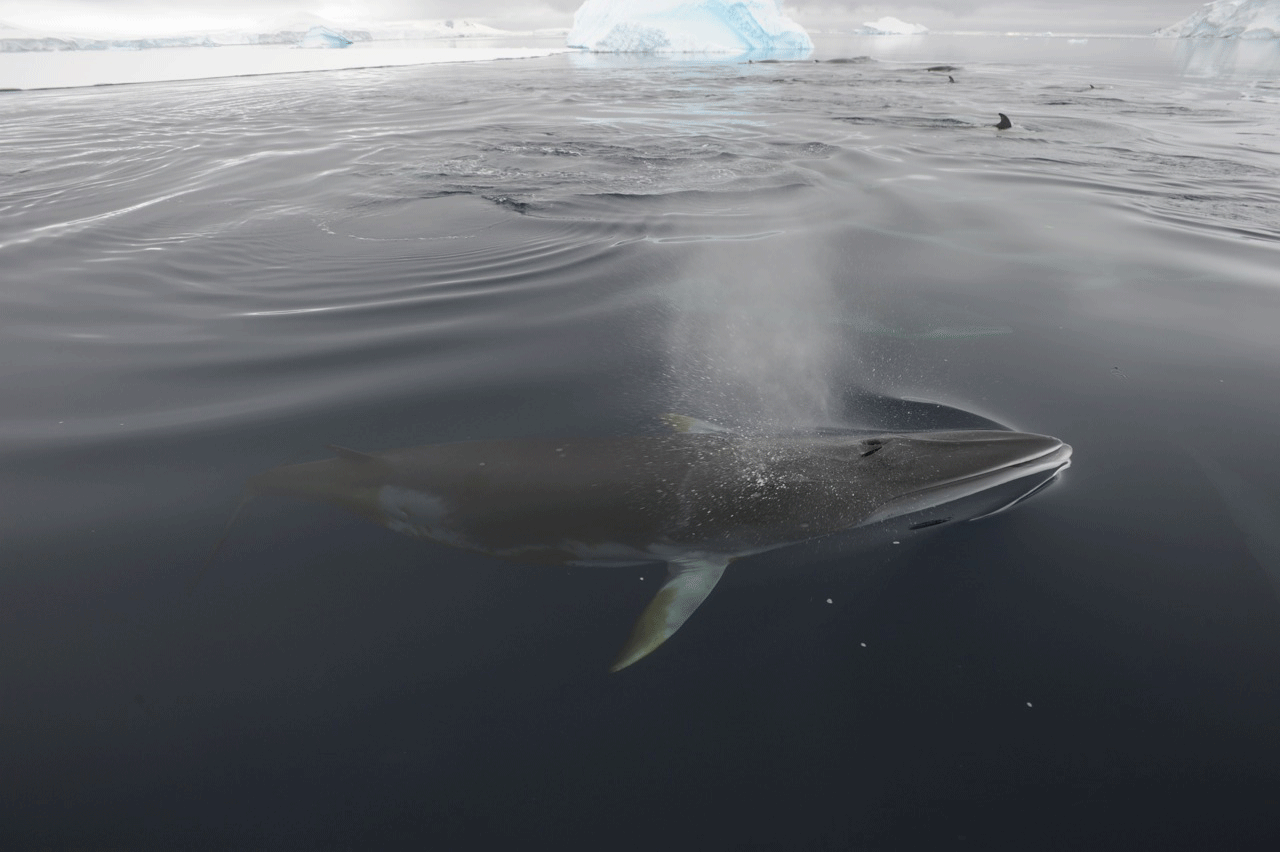
Minke whale coming up for air in Wilhelmina Bay, Western Antarctic Peninsula (photo: Dr. Ari Friedlaender, Oregon State University.)
Related link:
Andy Read’s Marine Biology Lab at Duke University
[NEWSBREAK MUSIC: Boards Of Canada “Zoetrope” from “In A Beautiful Place Out In The Country” (Warp Records 2000)]
ANNOUNCER: Funding for Living on Earth comes from Stonyfield Farm, makers of organic yogurt, smoothies and more.
Big El Niño Coming?

An image of the Pacific Ocean on December 1, 1997 shows sea surface temperatures relative to normal ocean conditions. (NASA)
CURWOOD: The weather phenomenon known as El Niño is likely on its way back, and it could be back in a big way over the next year or two, thanks to conditions researchers are now observing in the tropical Pacific Ocean. And if El Niño does return it could intensify droughts and storms around the world. To lay out all the signs and symptoms, we turn to Kevin Trenberth. He’s a distinguished scientist in the climate analysis section at the National Center for Atmospheric Research.
TRENBERTH: El Niños occur about every three to seven years and in between times there is a build up of heat in the western Pacific. The trade winds blow across the Pacific, piling up warm water in the western Pacific. After a period of time, the ocean says ‘there’s too much warm water piling up here over by Indonesia, and I’m going to have an El Niño event’, and some of this warm water starts to spread back across the Pacific and the winds change as that happens. Then, once it gets rolling, it continues for nine months to a year.
CURWOOD: What are the signs you’re seeing right now that suggest an El Niño event is underway?
TRENBERTH: Firstly, this is the right time of year for the transition. The main time when El Niño tends to get started is March, April, May, so this is certainly the time to watch. The second thing is that there have been a quick reversal of the normal easterly trade winds to brief westerly wind bursts.
CURWOOD: And what about water temperatures? What are you seeing there that might suggest that an El Niño is starting?
TRENBERTH: Well, certainly the upper layer of the ocean down to what oceanographers call the thermocline is quite warm and some of the temperature anomalies there are up to about eight degrees Fahrenheit above normal. The last time we’ve seen those kinds of numbers is 1997, 1998, during the big El Niño event. That’s the time when El Niño really came into the American vernacular.
CURWOOD: So tell us, what type of weather might we expect then if it turns out to be a fuerte El Niño?
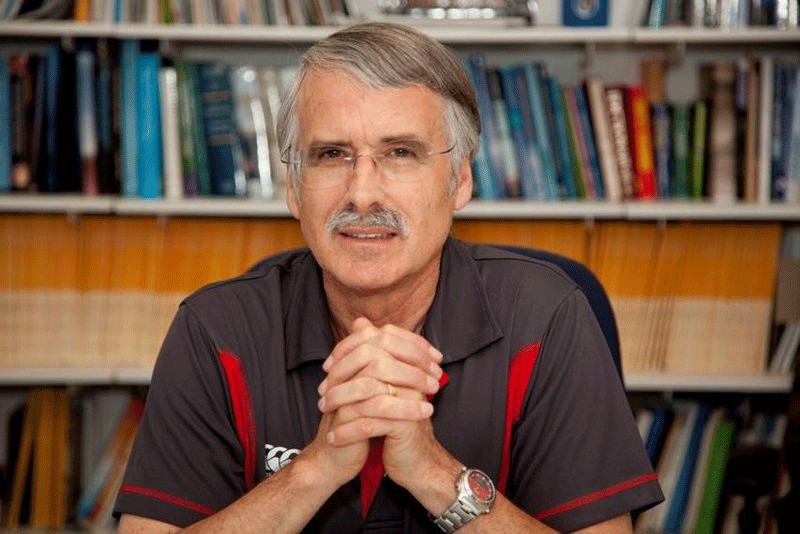
Kevin Trenberth is a Distinguished Senior Scientist in the Climate Analysis Section at the National Center for Atmospheric Research. (NCAR)
TRENBERTH: Well, the first thing is this upcoming summer. If it warms up sufficiently by July, then it means that the Pacific is where the main action is. At the same time, there’s a lot less action in the Atlantic, so a subdued Atlantic hurricane season is in the cards in that case. 1997, as a case in point, is the most active hurricane season ever on record. The places where the hurricanes and typhoons tend to occur is a bit different. There’s a greater risk of a hurricane going into Hawaii or into Tahiti. And then, as we go into the wintertime, there’s much greater odds of storms barreling into southern California and some parts of those continue across the south even to Florida, much wetter conditions in Florida and at the same time warmer and somewhat dryer conditions in the northern plain states.
CURWOOD: Now, to what extent is this good news for California? California’s been really tight on water these days...a lot of drought. Does a big El Niño...how much wetter might it become?
TRENBERTH: Well, this is especially, in some ways, good for southern California. It can end up replenishing a lot of their water resources and filling up reservoirs and so on. At the same time, some of these storms can be quite severe. There’s likely to be coastal erosion. There can also be flooding events. So the ability to be able to manage these kinds of extremes - the short-term extremes for the benefit of the longer term water use - comes into play.
CURWOOD: Now what about the rest of the world? How does this affect drought in places like Brazil and Africa, Australia?
TRENBERTH: The first place, Australia, it greatly increases the risk of drought there, and they’ve already had the warmest year on record in 2013 with quite a lot of reports of wildfires and with El Niño, this greatly exacerbates that kind of a problem. It also affects Southeast Asia and Indonesia, and increases the risk of fires in those places, as well as, especially the northeastern part of Brazil and parts of Africa are very much at greater risk of drought. At the same time, places like Peru and Ecuador are potentially in for deluges and flooding and big changes there.
CURWOOD: Now, as I recall, back in 1998, there was this huge set of icestorms in the east, and the finger was pointed at El Niño.
TRENBERTH: Yes, there were some unusual conditions. So it was relatively warm in many parts of the world, because one of the things that happened during El Niño is this heat spreads across the Pacific. It comes into the atmosphere mainly in the form of evaporative cooling of the ocean and more moisture in the atmosphere, so that invigorates storm systems and weather systems, but it ends up heating the atmosphere and there’s a mini global warming. 1998 was the warmest year on record. In winter, we still have cold continental conditions, of course. But sometimes, this warm air can meet up with that, and one of the consequences, - I think it was January 1998 - was a major ice storm, one of the worst on record in New England, and New York and especially in Canada. It caused major dislocations. It brought down the whole poles and structures that the wires were suspended on.
CURWOOD: To what extent do you think the climate change warming of the world’s oceans is a factor in more frequent or stronger El Niño events?
TRENBERTH: This is very hard to tell, and it’s a very important question. What we can say is that when an El Niño happens, because of climate change, the floods and the droughts in different places around the world tend to be stronger than they otherwise would be. And so those are often things which are often quite difficult to manage and they can cause big disasters. We’ve just seen the kind of things that can happen in the Seattle area with this big mudslide, for instance, with some loss of life there. And so, yes, watch out for these kinds of things.
CURWOOD: So, El Niño coming...strap yourself in, huh?
TRENBERTH: Well, yes, as I say, the technology we have nowadays means that we should be able to get a pretty good handle on whether this is really going to happen, and what it looks like, I think, in about a couple of months of so. We’re almost guaranteed that this next year will be rather different than the last three or four that we’ve had at least.
CURWOOD: Kevin Trenberth is a distinguished senior scientist in the climate analysis section at the National Center for Atmospheric Research. Thanks so much for taking the time with us today, Kevin.
TRENBERTH: You're most welcome.

The 1997 el Niño related ice storm damaged electrical wires in the Northeast. (Wikimedia.org)
Related link:
NCAR
[MUSIC: “Gil Scott Heron “The Needles Eye” from Pieces Of A Man (Ace records Reissue 2014)]
CURWOOD: Coming up...global oil and gas giant ExxonMobil thinks the risks of climate change are real, and plans to keep on drilling. Keep listening to Living on Earth.
[CUTAWAY MUSIC: Larry Coryell: “Clear Skies” from The Lift (Wide Hive Records 2013)]
Washington State Landslide -- Living with Risk
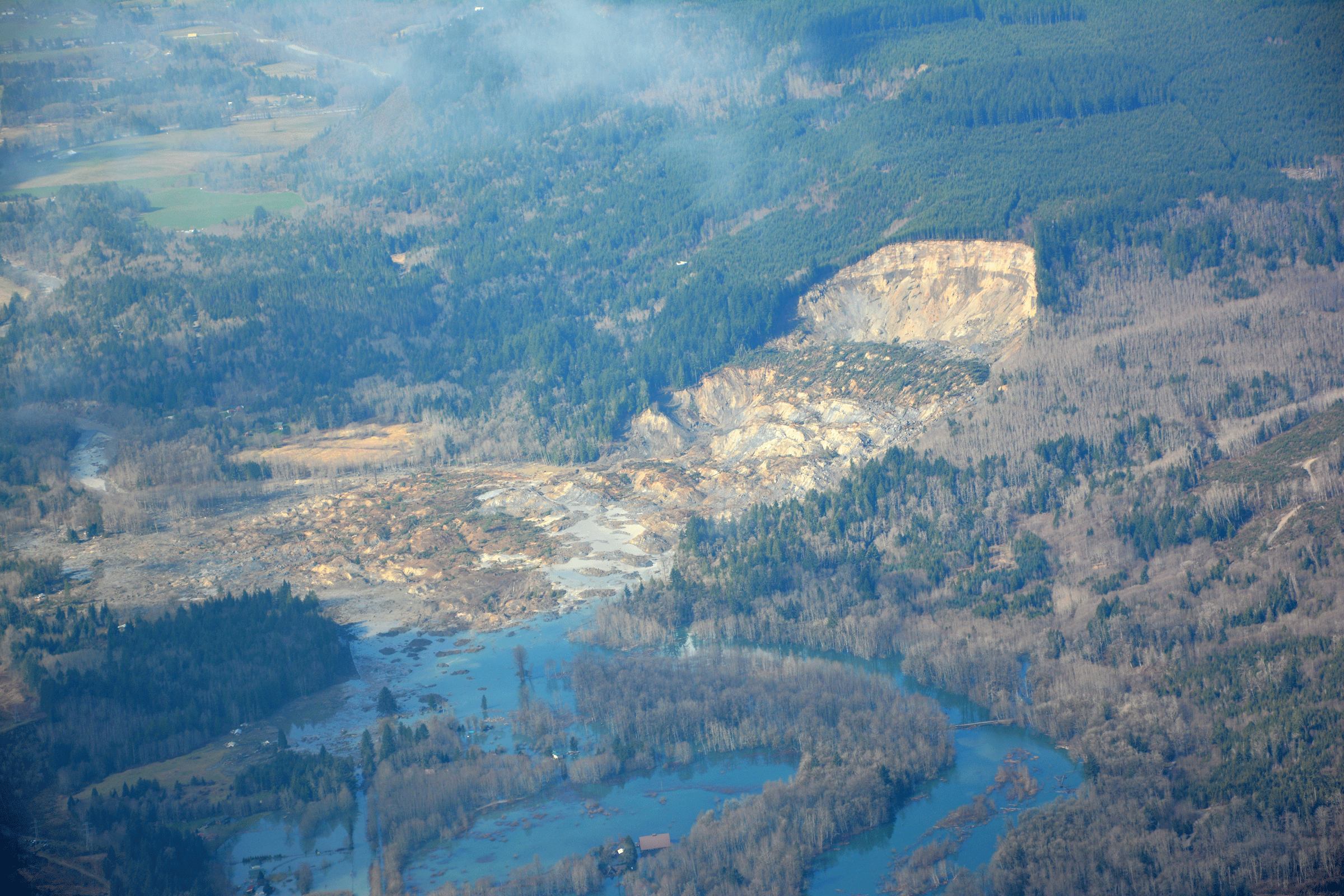
An aerial view of the Oso, Washington landslide (photo: Washington State Department on Transportation)
CURWOOD: It's Living on Earth, I'm Steve Curwood. President Obama has declared the devastating March 22 landslide in the Cascades a major disaster, making more programs and recovery aid available to Washington State. Some 50 people are dead or missing, most of them from a small community tucked into a bend in the Stillaguamish River. Ashley Ahearn of the public radio collaborative Earthfix has been covering the disaster since it happened. She reports that the danger of landslides was known, but that didn't stop local officials from allowing homes to be built there.
AHEARN: Bonnie Brown sent me a picture of the cabin her parents built near the Stillaguamish River in the 70s.
BROWN: It was just a very beautiful place, with beaver ponds and streams and meadows and trails through the wood. The kind of place kids dream of.
AHEARN: She also sent me an aerial photo of the cabin after the tragic landslide.
BROWN: There’s some grass around the cabin on three sides left but, other than that…
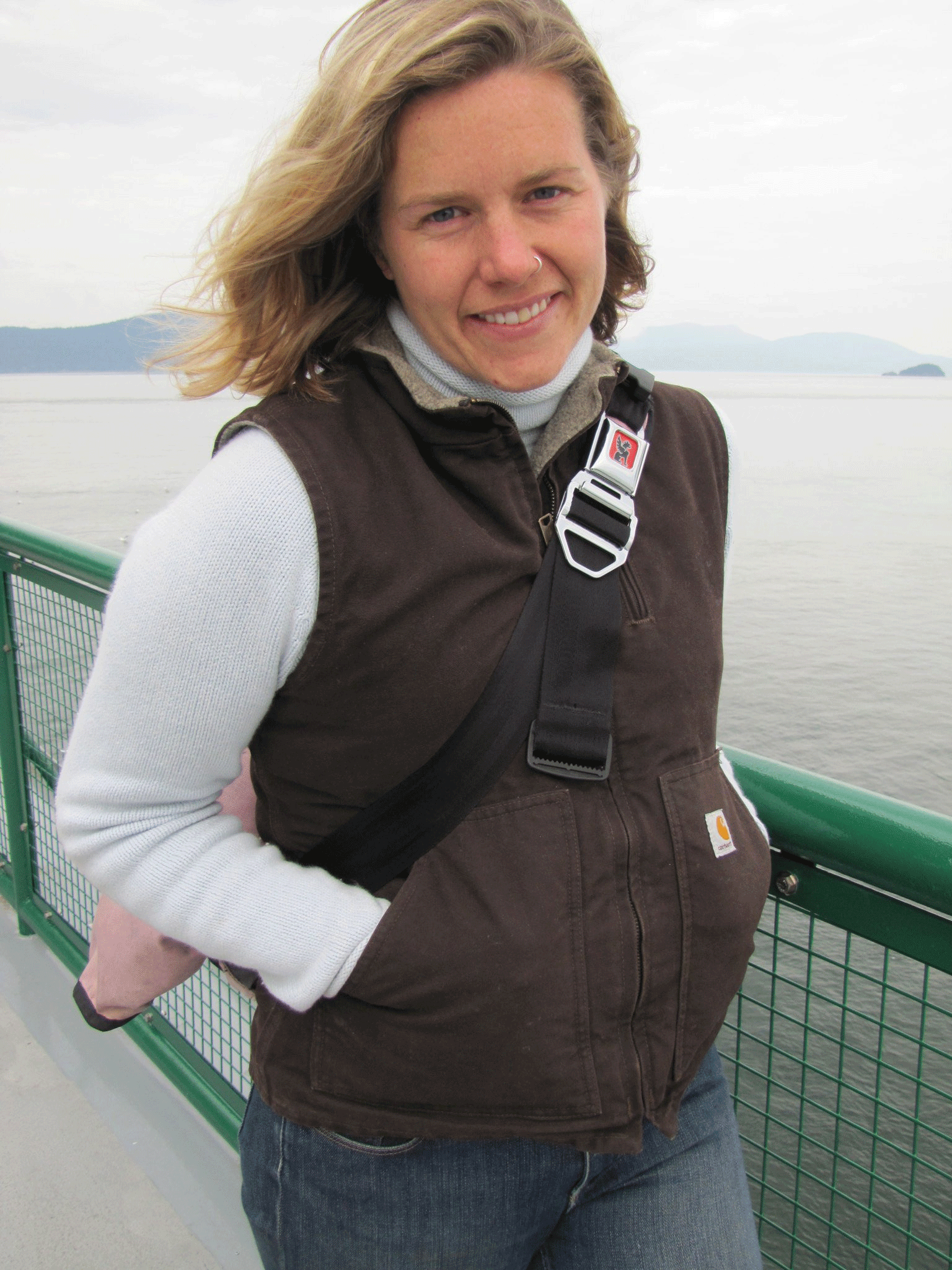
Ashley Ahearn covers science and the environment for KUOW and EarthFix, a multimedia reporting project based in the Northwest. (photo: EarthFix)
AHEARN: Her voice trails off. The second picture shows giant gray fingers of rock and muck and debris encircling the little log cabin. The slide came down from the cliffs across the river, then up the other side, covering the neighborhood. Brown’s family wasn’t at the cabin when the slide occurred. She said over the years her father and neighbors worried about flooding as the Stillaguamish meandered back and forth across its bed. Landslides weren’t at the top of their list of concerns. But maybe they should have been. Dan McShane is a geologist in Whatcom County. He said when he heard there was a landslide on the Stillaguamish he wasn’t surprised.
MCSHANE: The Stillaguamish setting, the geologic units, are particularly sensitive relative to, say a real solid granite bedrock somewhere else. So the potential for the failure is much greater.
AHEARN: Towards the end of the last ice age the Stillaguamish River was a giant lake blocked in by a glacier. It filled with soft lake sediments –- sand, clay, gravel – the kind of stuff that falls apart when it’s wet. And in recent years, scientists are getting a clearer and clearer picture of the scars on this landscape. Modern imaging technology called LIDAR shows three-D representations of the Stillaguamish River bed today. It looks like a little kid took a toy dumptruck with a backhoe and just moved along the river taking giant clam shell bites out of the slopes. Those bites show where landslides have occurred in the past. McShane says anyone can look at maps and get information like this if they have some time to surf the web.
MCSHANE: You know, it’s public but whether it gets to some of the people that make land use decisions and planning for geologic hazards doesn’t necessarily always happen.
AHEARN: The disconnect between the science and planners may have cost some of the residents of Steelhead drive in Oso, Washington their lives. A landslide occurred in the same place on the Stillaguamish in 2006 causing flooding. Snohomish county permitted 5 new homes to be built there that year and another one in 2009.
The Snohomish planning office said they couldn’t comment as to why those permits were issued because they’re busy with the recovery effort. McShane and others have said the size and reach of this landslide in particular was unprecedented. No two counties are the same when it comes to incorporating things like new geological mapping technology into their planning or permitting process. A lot of that variability stems from money says Scott Burns, he’s a geologist with Portland State University.
BURNS: We can make landslide hazard maps just like earthquake hazard maps, just like flood hazard maps, but very few of them have been done because we are in a cutback government mode.
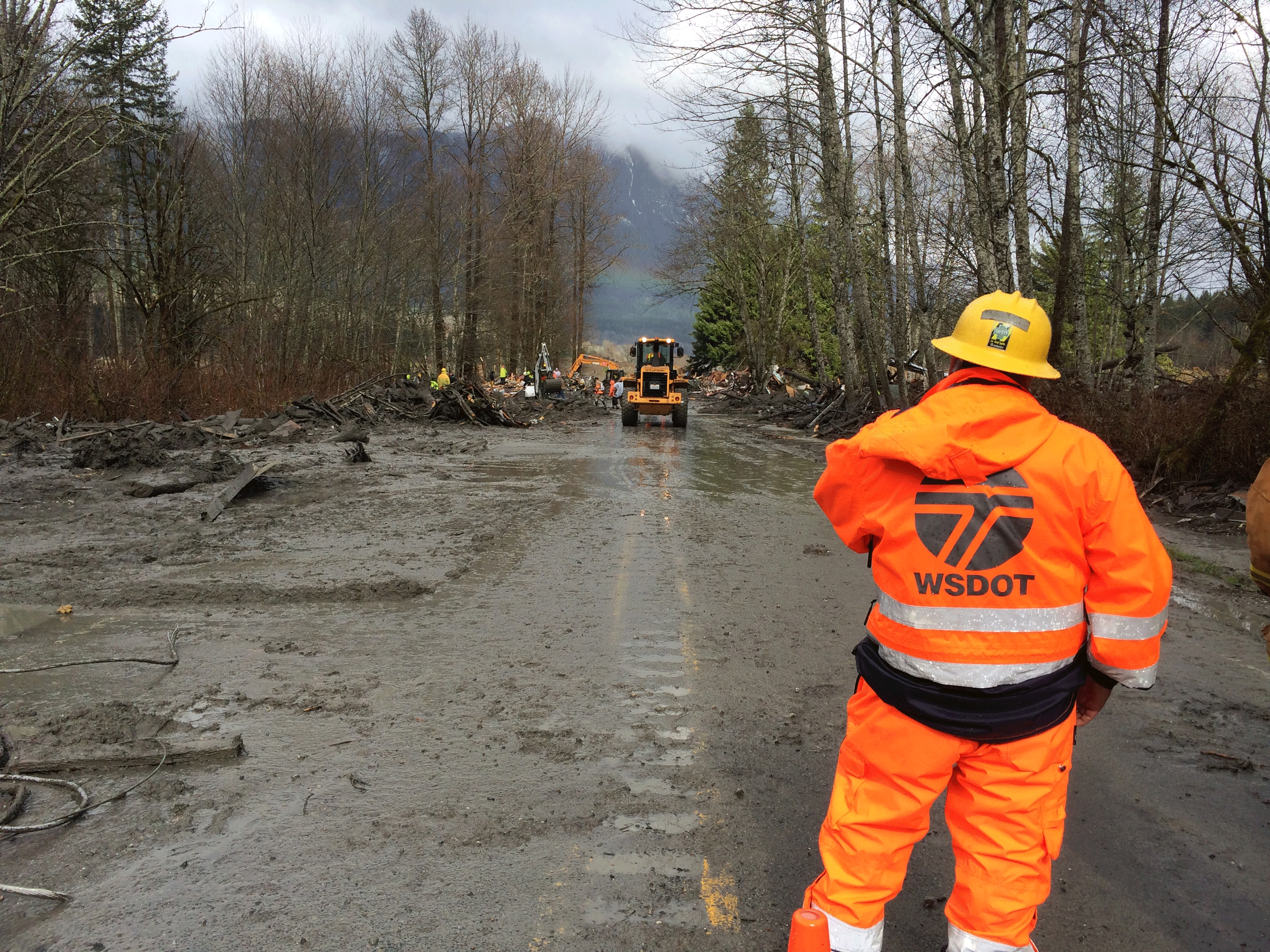
Department of Transportation officials try to clear a path to the landslide (photo: WSDOT)
AHEARN: The Washington Department of Natural Resources has detailed maps, although they’re not as detailed as some of the latest 3D imaging. Some counties, like Cowlitz and Jefferson are incorporating new landslide data into their websites. Burns says there’s a ways to go and the government needs to invest in hazard maps and use them in the permitting process.
When Bonnie Brown’s father built her cabin in the 70s the mapping technology we have today didn’t exist. But technology or not she has no plans to rebuild.
BROWN: The land and what we enjoyed around there is gone. I don’t know how long it will take for nature to recover but what was really our family’s past is gone now.
CURWOOD: That's Earthfix reporter Ashley Ahearn, and she joins us on the line now from Seattle. Welcome, Ashley.
AHEARN: Hey, Steve.
CURWOOD: So we're two weeks from the disaster now. Do officials have any more concrete information about what caused this horrible slide?
AHEARN: Well, initially, they were looking at the actual geology of the area and seeing how the toe of the slide was sliding into the Stillaguamish River. And the river was sort of eating away at the base of it, so that was allowing the slide to keep going and kind of destabilizing that earth. But there are other factors that were at play here as well. We’ve had a lot of rainfall this season, in March particularly. It broke records in Seattle, and Darrington, the nearest town that has a weather monitor system, had almost 19 inches of rain in March, which is I think the second highest amount of rain on record for that town. So there’s the rainfall, and we know that heavy rains contribute to these deep-seated landslides that destabilize the landscape.
And then the other factor is logging. The state Department of Natural Resources permitted some logging to happen above the slide area. The timber company, this is Grandy Lake Forest Associates, cut outside of their allotted area. So they were not allowed to be logging as close to the top of the slide as they did, and some people are saying that may have contributed to the loss of the slope stability there as well.
CURWOOD: How soon will we know if there’s any idea of what will happen to that area of that river valley?
AHEARN: You know, I think that people are still getting their heads around the human tragedy and the scope of it. The amount of earth that is just covering this area makes it hard to picture where you would even put a house if you were going to try to rebuild. The question of who builds on this plot, that’s probably too soon to say. I would be surprised if that happens anytime soon, and, furthermore, if it’s permitted ever again.
CURWOOD: Now, Ashley, you’ve been reporting on another rural community that lives with constant danger of landslides, but hasn’t yet had any major disaster or any loss of life. What did you learn about the people who choose to live there?
AHEARN: Yes, I want to take you to another community just north in the Cascade Mountains as well. This is a community along the Skykomish River, and it’s called the Mount Index River Sites, and this is kind of a loose community of houses, cabins mostly, people who’ve lived out there for decades along this beautiful stretch of river near a place called Sunset Falls. And they have slides there a lot. The road washed out in 2009, and this winter they have been absolutely hammered.
The interesting thing about this community is they’re on a private road so they’re not getting any state dollars to help with road maintenance. So it’s on the community. And the people that live in this community don’t have a lot of money and so spending more than $60,000 on this road….they’ve come to the point where the landslide’s won, and they probably won’t be rebuilding this road any time soon. And so half the community is cut off from access to Route 2, and the people are getting to their homes using ATVs.
So I went out there to ask just what is this place that draws you here, and I met a guy named Loren Brayton. His family has owned land next to Sunset Falls on the Skykomish since 1972. And when I caught up to him he was actually chopping up wood...he’s building a cabin right next to the slide area. I asked him if he’d compare his community to Oso. This is what he said:
BRAYTON: For all the people here there was personal property loss and there was real estate loss. We had no deaths. So I compare this to Oso. I feel for them more than I do for us. We’ll recover.
AHEARN: If there were people in these houses?
BRAYTON: They would have been gone.
AHEARN: Does that make you scared as a homeowner?
BRAYTON: No. When it’s time to go you’ll go. Well like yesterday, I was up here and it slid below me. The only concern I had was getting my tools in and getting them safe for the night because I’ll always work my way out.
CURWOOD: Wow, Ashley, that's quite a response. How are other people reacting?
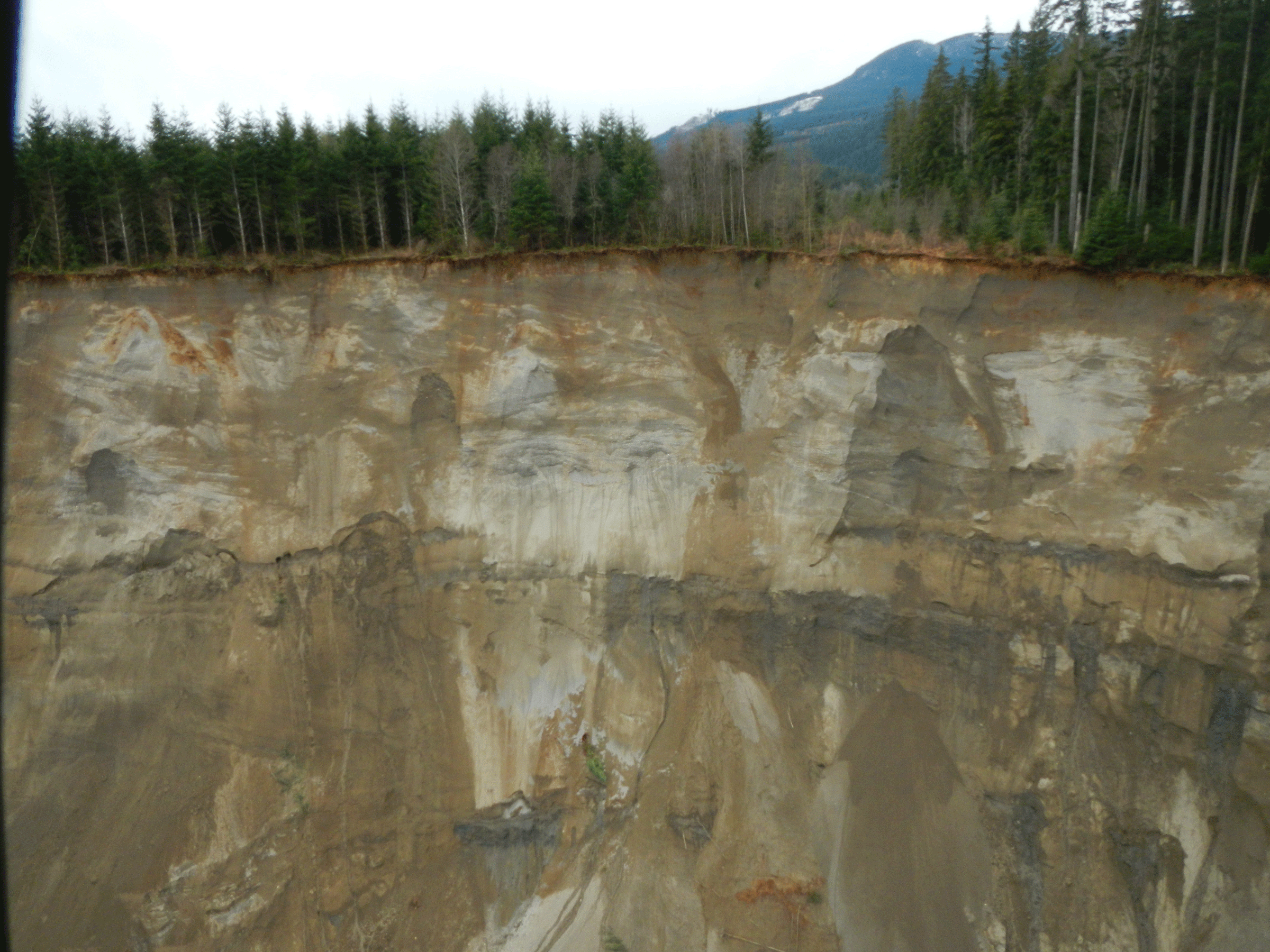
The slope that gave way (photo: Washington State Department of Transportation)
AHEARN: Yeah, Loren wants to retire there. He loves the natural beauty and the sanctuary. But down that same dirt road you’ll meet a variety of people and different perspectives.
I met a guy named Ben Van Dusen, and he’s lived out there for 20 years. The Oso landslide has him a bit more worried about the land and really what it’s capable of doing. His house has flooded before. The road has washed completely into the river near his house in the past. But he says, for him, there aren’t a lot of options.
VAN DUSEN: Right now, today, I am stuck. I’ve turned the hot water off. I don’t have TV, Comcast, I don’t have any of that, I get DVDs from the library. So I am stuck. If that’s a dangerous slope, too bad. This is it.
AHEARN: He thinks the government should buy the homeowners out, all the people that live down this dirt road. He thinks this should be a place to visit, not a place to live. There’s a lot of hiking in the area, a lot of outdoor recreation opportunities, rafting, that sort of thing. And he said, if I had a choice, if I had an infusion of cash, I would probably move some place safer.
CURWOOD: Now, Ashley, you’re going to stick around the slide area in these coming weeks, do some more reporting. What are you going to look into?
AHEARN: Right, I’m going to be heading up this week talking to folks at the Environmental Protection Agency. They are going to be on the ground looking for things like hazardous materials. What kind of stuff comes out of a disaster like this, and potentially ends up in the river?
I’m also going to be looking into questions of planning and growth management... and really, what other cities in the state are vulnerable and may not know it? And the other thing is how did the Department of Natural Resources not follow up or reprimand this timber company when they were cutting outside their allotted area?
This is a tragedy that scientists and policymakers will be analyzing for years. My hope is we learn something from it, and that we never forget these people and what they lost.
CURWOOD: Ashley Ahearn reports for public media collaborative's EarthFix. Thanks so much for taking the time, Ashley.
AHEARN: Thanks for having me, Steve.
Related link:
Washington State, Oso, landslide, Cascades, planning, county planning
[MUSIC: The Mulchmen “Mudslide” from Louder Than Dirt, Thicker Than Mud (Big Beef Records 1997)]
Exxon: The Economy Is Stronger Than the Environment

An ocean oil rig (photo: bigstockphoto.com)
CURWOOD: The International Energy Agency, the IEA, says that two-thirds of all fossil fuel reserves will need to stay in the ground to stop the earth warming more than two degrees Celsius.
Well, last week we talked with Danielle Fugere, the President of a shareholder advocacy group called As You Sow. Her group filed shareholder resolutions with major fossil fuel companies asking them to disclose their plans to cope with potential carbon regulation.
ExxonMobil is the world’s largest investor-owned gas and oil company, and the first to respond. So As You Sow withdrew its shareholder resolution, and ExxonMobil released a detailed outlook which acknowledges the reality of climate change and the possibility of future carbon regulation. But Ken Cohen, Vice President of Public and Government Affairs for ExxonMobil Corporation, believes demand for fossil fuels will remain strong. He spoke to us from Irving, Texas.
COHEN: The risk of climate change is clear and it warrants action, but it doesn’t exist as a risk in isolation. We have to manage the risk of climate change while at the same time that we provide economic opportunity, that we lift billions of people out of poverty. 1.3 billion people in the world do not have access to electricity. People around the world want the same things that you and I take for granted here in the United States. They want access to modern forms of energy. They would like to heat their homes. They would like air conditioning. They would like to have modern forms of transportation and all available sources of energy are going to be needed to meet this growing demand and both the IEA and ExxonMobil’s outlook predict that carbon based fuels are going to provide approximately 75 percent of global energy needs out to the year 2040.
CURWOOD: Now many of the world’s leaders, major world leaders including President Obama, have agreed that in order to keep global temperature rise below two degrees centigrade and avoid the worst consequences of climate change, we need to reduce our carbon emissions by as much as about 80 percent by 2050. What do you make of that?
COHEN: We factor into our energy outlook, and we expect, additional regulations that would apply to hydrocarbon fuels. In fact, we use a...what I would call a ‘proxy cost’ for carbon regulation in our annual energy outlook. And in fact, going out from today to the year 2040, we use as a proxy cost, about $80 a ton of carbon. Now when you think, today the European trading scheme, emissions trading scheme, has an $8 to $10 a ton price affixed to it, we are being very prudent in our planning process, in taking into account additional regulation on our business.
CURWOOD: So, if I understand you correctly, in looking through your report, it would seem that it would take carbon being $200 a ton to severely restrict the use of fossil fuels...that you see that as an unlikely outcome at this point?
COHEN: Again, we need to address the challenge of climate change in the context of other pressing societal challenges. And one of the most pressing the world is still dealing with is the economy, the strength of the economy. And governments are proceeding very cautiously in the application of regulations that are going to impose additional costs on consumers.
CURWOOD: You point out it’s really important to help less developed societies move forward in the modern world, but what about the question of using alternative energy to fuel that development as opposed to energy containing a lot of carbon.
COHEN: That’s a good question, and our outlook contemplates the continued growth of renewable energy on a global basis, and in fact, in our outlook, you will note that the fastest growth rate is attributable to renewables like wind and solar. But even with that almost heroic growth rate really for renewable fuels, we still project that energy demand will be met by over 75 percent of it is going to be coming from oil, gas, and coal. And that is because of the massive size of the global energy system, and the fact that the global population today is about seven billion people. In the year 2040, there will be about nine billion people, and the nine billion consumers of energy want the same things you and I take for granted.

Ken Cohen (photo: ExxonMobil)
CURWOOD: So what about the irony that the world’s poorest people in developing countries, those that you say need this increase in energy, are most at the risk from the threats of climate change?
COHEN: The way that we, as a society, address environmental challenges is through economic development and technology. And of the 1.3 billion people in the world that don’t have access to electricity, those societies need to continue to develop economically so that they are able to take on the environmental challenges that they face. The solutions to the problems that we’re dealing with have at their bedrock, economic development and technology application, developing technology and applying technology.
CURWOOD: So look into your crystal ball, Ken Cohen, and tell me what you expect Exxon to look like in the year 2050.
COHEN: Well, I believe...we’re a company that employs 18,000 scientists and engineers, and I’ve been with the company for three decades, and the things that we’re doing today from an engineering and technology standpoint are amazing. We have a number of very very bright and talented researchers that are focused on what the future may look like.
CURWOOD: So what does that mean for your solar and wind portfolio?
COHEN: Well, so far, we have...we used to...it’s interesting, in my career, the company actually was a large player in solar energy, but we got out of that business a number of years ago because we couldn’t make money in solar energy. If we see an opportunity that matches up well for the company, then I’m sure that we will consider getting back into that space. But right now, we have our hands full doing two things, which is producing the energy that the world is running on today, but while we’re doing that, continuing to focus on reducing the greenhouse gas emissions footprint associated with that activity.
CURWOOD: Ken Cohen is Vice President of Public and Government Affairs for ExxonMobil Corporation. Thanks for taking the time with me today, Ken.
COHEN: Steve, thank you for the opportunity to talk about these issues.
Related links:
- Read ExxonMobil’s report on Climate Change
- Read the original shareholder resolution from As You Sow
- Writer and fossil fuel divestment activist Bill McKibben’s response to the ExxonMobil report published in the Guardian
[MUSIC: Miles Davis “Willie Nelson” from Miles At The Fillmore, Miles Davis 1970: The Bootleg Series Vol 3 (Columbia Legacy 2014)]
CURWOOD: Coming up...
Seas rise, islands drown,
Acid oceans kill sea-life,
Climate change – no fun.
An oceanographer distills the UN's climate report – into haiku. That's just ahead on Living on Earth. Stay tuned.
ANNOUNCER: Funding for Living on Earth comes from the Grantham Foundation for the protection of the environment, supporting strategic communications and collaboration in solving the world’s most pressing environmental problems. The Kendeda Fund, furthering the values that contribute to a healthy planet, and Gilman Ordway for the coverage of conservation and environmental change. This is PRI, Public Radio International.
[CUTAWAY MUSIC: David Fathead Newman: “Unspeakable Times” from The Gift (High Note Records 2003)]
Beyond the Headlines
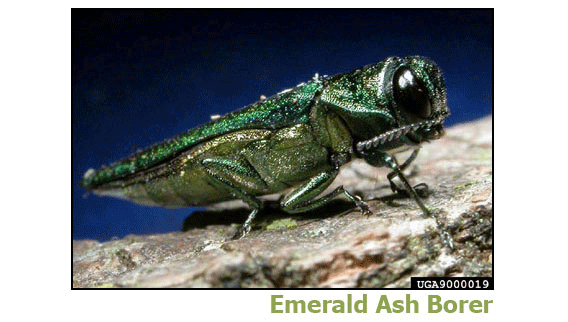
The Emerald Ash Borer is a threat to ash trees, which are used to make professional baseball bats. (Virginia Department of Conservation and Recreation)
CURWOOD: It's Living on Earth, I'm Steve Curwood. Time now for our weekly foray beyond the headlines with Peter Dykstra, the publisher of DailyClimate.org and Environmental Health News - that's EHN.org. He's on the line from Conyers, Georgia. Hi, Peter.
DYKSTRA: Hi, Steve. I'm going to brag a little bit this week on the work of two colleagues of ours at The Daily Climate. Our reporter Lindsey Konkel did a story on a peer-reviewed effort to learn more about the climate record through artwork. It was just published in the journal Atmospheric Chemistry and Physics and in the paper, researchers from Greece and Germany analyzed 124 sunsets painted by European artists recently and as far back as 500 years or so. The researchers noticed a consistent pattern that whenever paintings were made after a big volcanic eruption, the sunsets were painted redder and more intense.
CURWOOD: It’s not just those German romantics got more intense? It’s telling us that there really are scientific blanks we can fill in using art, huh?
DYKSTRA: No, it’s not the German romantics. What it is is more particulates in the air means brighter sunsets, but that same volcanic debris can also cool the planet and it can also make it harder to breathe. The researchers also saw a steady increase in redder sunsets since the Industrial Revolution began.
CURWOOD: So some evidence of both nature’s impact on the atmosphere and humanities. You said you have something else from a colleague at The Daily Climate?
DYKSTRA: Right, this week we started up Major League Baseball again, and our reporter Brian Bienkowski had an opening day unlikely environmental chat with the boss of the makers of Louisville Sluggers, the classic baseball bats. Ash wood is still the standard bearer for the wooden bats used in professional baseball, but a little invader species is eating the ash trees.
CURWOOD: Uh oh, another invasive insect?
DYKSTRA: Yes, the Emerald Ash Borer, first discovered in this country about a dozen years ago, is chomping its way northward thanks to warmer weather. They were probably slowed down a bit by this cold winter in the eastern US, but they’ve become a serious threat to the baseball bat forests in Pennsylvania.
CURWOOD: And what happens if the prime ash forests get eaten?
DYKSTRA: Well of course, amateur baseball has pretty much completely switched to aluminum bats, and some pros have their bats made from other woods, like birch or maple, but this really is a threat to an iconic part of the game.
CURWOOD: We pay $8 for a hot dog at the game, but Emerald Ash Borers eat for free on Big League Baseball.
DYKSTRA: Good point.
CURWOOD: And, Peter, you still have your Louisville Slugger, right?
DYKSTRA: Yes, but it’s mostly for home security and road rage now.
CURWOOD: [LAUGHS] Hey, before you go, what’s on the calendar this week?
DYKSTRA: I have some more stuff about eating. Ash Borers eat baseball bats, politicians often dine on their own words very frequently, and here are a couple of examples. Four years ago this past week, President Obama opened up huge areas for offshore drilling and after he did that, he famously explained that, “Oil rigs don’t usually cause spills.” And of course, you know what happened three weeks later.
CURWOOD: Oh yes, Deepwater Horizon disaster! It’s one of the worst spills in US history.
DYKSTRA: Exactly. And 31 years ago this week, the other example of politicians eating their words, the Interior Secretary James Watt announced the cancelation of the traditional Fourth of July concert on the Washington Mall. Why? Because he said the Beach Boys - the Beach Boys! - would attract what he called the wrong element.
CURWOOD: But weren’t Mr. Watt’s boss and the boss’s wife big fans of the Beach Boys?
DYKSTRA: Not only that, but the Beach Boys actually campaigned for Ronald Reagan, they were good pals with Nancy Reagan, the First Lady. By the following July 4 and following a few more gaffes by James Watt, he was gone as Interior Secretary, and the Beach Boys were back performing on the Fourth of July.
CURWOOD: Making a good vibration, huh?
DYKSTRA: Absolutely.
CURWOOD: Peter Dykstra is publisher of EnvironmentalHealthNews.org and DailyClimate.org. Thanks so much for taking the time today.
DYKSTRA: Thanks a lot, Steve, we'll talk to you soon.
Related links:
- Environmental Health News
- The Daily Climate
[MUSIC: Devo “Gut Feeling/Slap Your Mammy” from Are We Not Men ? We Are Devo (Warner Bros. 1978)]
Maple Syrup and Climate Change
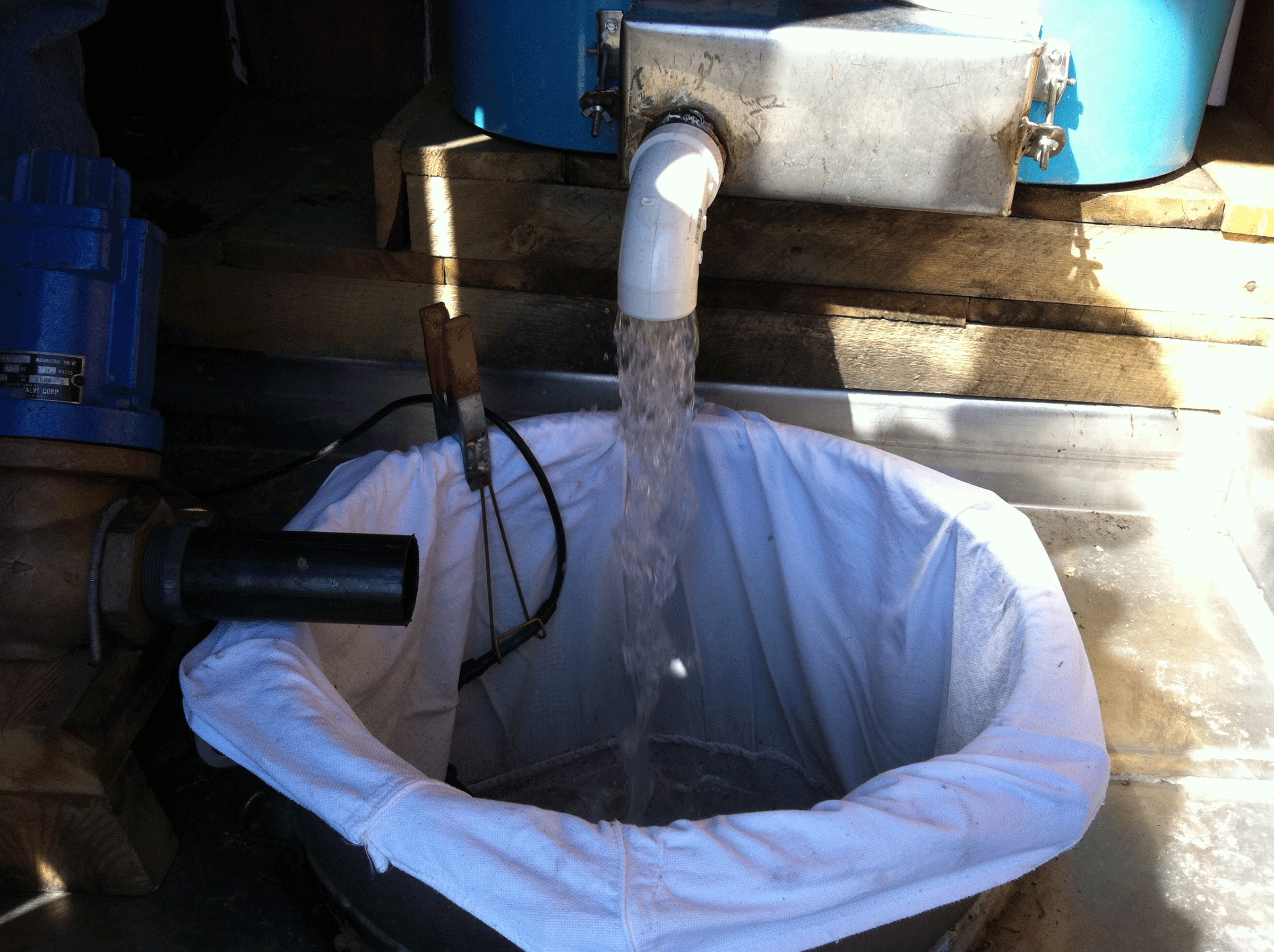
Sweet maple sap pours into a bucket (photo: Julie Grant)
CURWOOD: There’s nothing like real maple syrup on a pancake or waffle, and these days technology has boosted the yields of sugar maples - as long as the weather cooperates. Sugar bush owners in the Northeast and Canada are finding the weather more and more erratic, with record cold followed by record heat, gyrations that that interrupt the flow of sap. And thanks to warming, the sugaring season is already about ten percent shorter than it was a few decades ago. Also, long-term federal climate predictions suggest rising temperatures could wipe out most northeastern maple groves by next century. But right now producers aren’t too worried as maple syrup prices are high and in many places the sap is flowing just fine. Julie Grant of the public radio program the Allegheny Front has our story.
[OUTDOORS AT MAPLE FARM]
GRANT: Jason Blocher’s livelihood each year largely depends on the weather in February and March. He’s the third generation in his family to run Milroy Maple Farms in Somerset County, on Pennsylvania’s southern border, just a few miles from Maryland.
BLOCHER: You can’t outguess Mother Nature, and she controls everything in this business.
GRANT: It takes warm days and cold nights to get sap flowing through a sugar maple.
[TAP DRILL]
GRANT: They start drilling tap holes in the trees when daytime temperatures get in the 40s, and nights are still below freezing. When Blocher was a kid, they would tap in late February and early March. But he says that’s changed in the past ten years. Now, they usually tap earlier as much as month earlier. And the timing is more erratic.
Like most producers, Blocher remembers the winter of 2012 there was a thick layer of snow in his maple forest. And then, right as syruping was starting, temperatures shot up into the 80s it was the warmest March on record.
BLOCHER: So we went from fighting our way through three or four feet of snow, and anticipation of a very good season, because of that heavy snow pack, to one of our poorest seasons we have on record because we had such a drastic change in the weather from cold, deep snow to too warm and in a matter of two weeks to three weeks, it ruined our season.
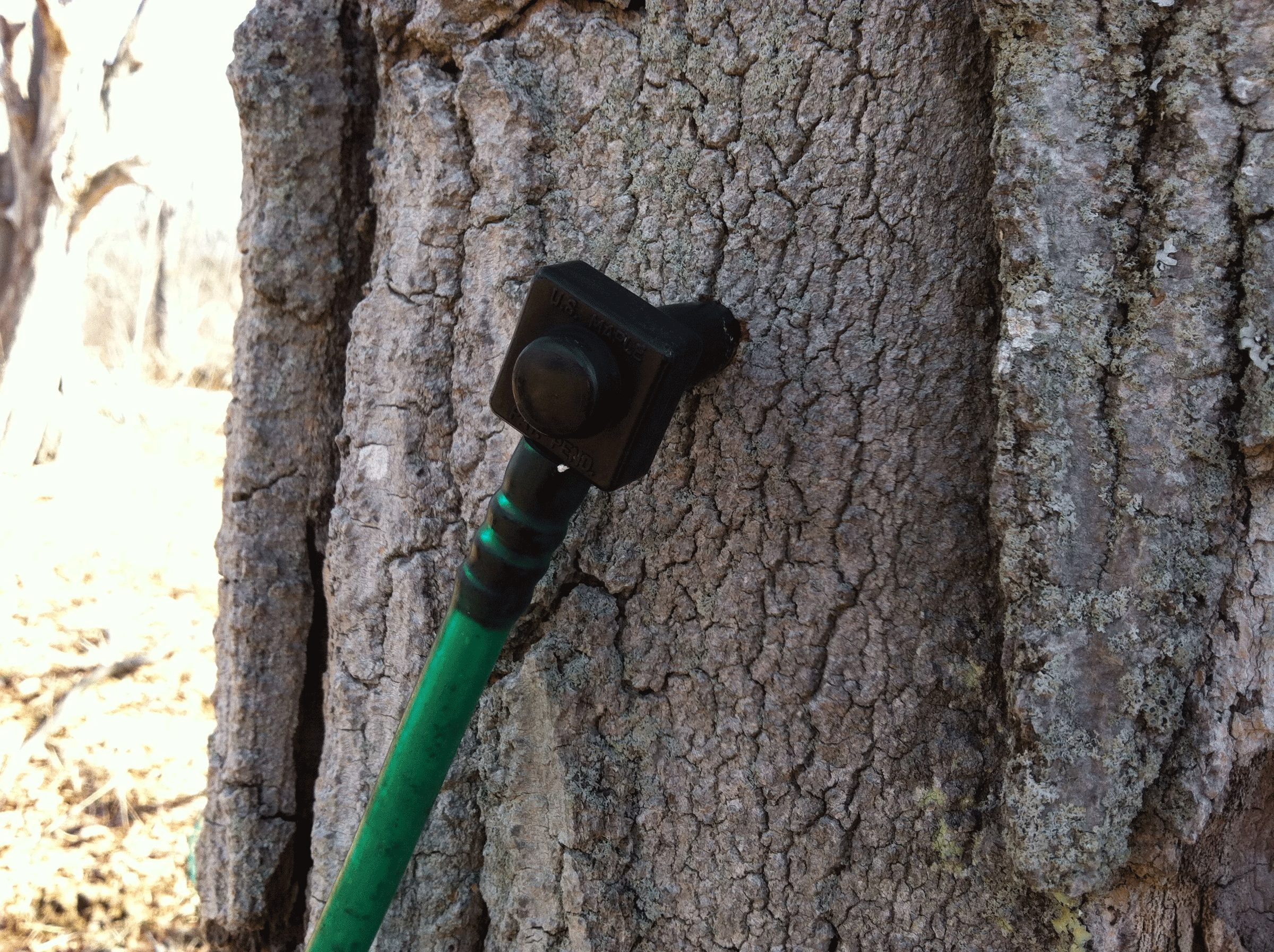
New technologies helps sugar producers pull much more sap from the maple trees.
(photo: Julie Grant)
GRANT: Milroy Farms wasn’t alone. Syrup production around the northeast U.S. was down 40 percent in 2012.
Erratic years like that aren’t a surprise to Dave Cleaves. He’s the climate change advisor at the U.S. Forest Service, which means he’s often the bearer of bad news.
CLEAVES: God, in this job I’m in, people hate to see me coming. They run like hell.
GRANT: About fifteen years ago, the Forest Service published what’s called the Climate Change Tree Atlas. And what it found didn’t look good for sugar maples in the Northeast.
CLEAVES: We will see it gradually disappear. Or become less prominent.
GRANT: Cleaves says southern Ohio, Pennsylvania, West Virginia, and Maryland are on the southern edge of large scale maple syrup production. He says as the climate changes, they’re the first places that will have troubles with maple trees.
CLEAVES: Because there are other more aggressive and adaptive southern species that are always there ready to take off and regenerate.
GRANT: Milroy Farms owner Jason Blocher says his maple grove grows along Mt. Davis, the highest point in Pennsylvania, which gives trees the colder temperatures they like, so he doesn’t get too worked up about climate change.
BLOCHER: Oh, you hear about that all the time. And the global warming. But I think the sugar maple is a very hardy tree, and very adaptable. So I think under slight changes and so forth, it will adapt.
GRANT: And some of the top maple syrup researchers in Vermont and New York agree with him. Temperatures in the northeast already have risen an average of twodegrees Fahrenheit since 1970, and they say maple syrup production is going gangbusters.
[VACUUM TUBING]
GRANT: Blocher is like most producers these days, he uses vacuum tubing to pull sap from the maple trees. This, coupled with other technologies, allows him to double production in half the time it took his parents.
Michael Farrell is a maple syrup expert at Cornell University, and runs a sugar bush in northern New York. In his book, the Sugarmaker’s Companion, he says newer forest models, which take factors other than climate into account, show that things don’t look as bad as the Forest Service predictions. Farrell says his own PhD research, looking at maple trees in the forest mix, backs that up.
FARRELL: We’re not getting replaced by oaks and hickories up here in the Northeast, it’s very unlikely that that’s going to happen. And the foresters down in the Midwest and Mid Atlantic, where there’s a lot of oak and hickory, they’re concerned that they’re not getting the regeneration of oak and hickory, and a lot of them consider sugar and red maple invasive species down there.
GRANT: But that’s not what the Forest Service is seeing in the long term, 85 years from now, in the time frame of a tree’s life. Dave Cleaves says maple producers and researchers may be experiencing good times now, trees aren’t falling over and dying. But forest service studies, that look at changes in the woodlands every few years, don’t find many maple saplings in the Northeast.

Jason Blocher's farm sells maple syrup and butter and candy. (photo: Julie Grant)
FARRELL: When they actually get down on the ground and count the seedlings by species, then they get an idea of what is the future forest likely to look like, because then we’re looking at the babies here.
GRANT: Cornell researcher Michael Farrell says the biggest danger to young sugar maples is deer, which can eat at the saplings. And syrup producers, like Jason Blocher, are more concerned about invasive insects, like the Asian Longhorned Beetle, than warming temperatures.
But the Forest Service’s Dave Cleaves says problems like these are intertwined with climate change.
CLEAVES: It’s not just the changing climate, itself, that impacts, it works through these stressors that are already there. Say it’s moisture stress on the forest if it gets too dry, or if it gets wetter and moister, and that’s more conducive to insect and disease proliferation, then it’s working through insect and disease.
GRANT: At Milroy Farms, Jason Blocher says there’s nothing he can do about global warming, so he doesn’t worry about it. But some forest researchers go so far as to call the maple tree a poster child for climate change in the Northeast, because they say it’s a resilient tree, that might not make it, unless efforts to cut greenhouse gases take root.
CURWOOD: That's Julie Grant of the public radio program the Allegheny Front.
Related link:
Allegheny Front
[MUSIC: Bill Frisell Winter Always Turns To Spring from Ghost Town (Nonesuch Records )]
UN Climate Change Reports As Haiku

The Future Haiku (Photo: Gregory Johnson)
CURWOOD: The periodic assessments from the Intergovernmental Panel on Climate Change, or IPCC, rely on a couple of thousand scientists from around the world. They produce a detailed appraisal of humanity’s impact on the climate and what that means now and in the future. These reports are notoriously dense and hard to read. Well, NOAA scientist Greg Johnson was a lead author for part of the assessment published last fall, and he's come up with a simple, elegant way to communicate the complex scientific findings - haiku.
Seas rise as they warm
Rates quicken last century
Melting ice joins in.
CURWOOD: Oceanographer Gregory Johnson joins me now to share more of these IPCC haikus. Welcome to Living on Earth, Greg.

Response Haiku (Photo: Gregory Johnson)
JOHNSON: Hi. Thanks, Steve.
CURWOOD: So how did you come up with the idea? IPCC as haiku?
JOHNSON: Well, actually, I was sick one weekend, and I was really sick enough to be unable to leave the house. And so I was trying to figure out what I would do for the weekend, and for some reason, I thought I would reread the summary for policy makers from the Working Group I report to the Intergovernmental Panel on Climate Change, that’s the one on the physical science basis of climate change. And like you said, they are very dense documents. So I was reading this, and I was having trouble concentrating.
CURWOOD: Wait. You’d worked on this. You knew what was supposed to be there, and you couldn’t stay focused?
JOHNSON: Well, I was a little sick. [LAUGHS] Well, anyways, I thought it would help fix it in my mind if I tried to compose a haiku for each of the subsections of the report. But I sat down and composed these haikus. It took most of the morning and a little bit past lunch, and then my wife said, “What on Earth are you doing?”
CURWOOD: [LAUGHS]
JOHNSON: And at that point, I sort of thought, Well, what am I doing? And I realized I could make them into an illustrated booklet to share with friends and family if I added some illustrations.
CURWOOD: So you’re an oceanographer for the National Oceanic and Atmospheric Administration, and you’re a lead author for the working group chapter on oceans, but this is not any kind of official document.
JOHNSON: That’s correct. These are solely my own creation. Any views or opinions expressed in these are my own, and do not necessarily reflect those of the United States government, the International Governmental Panel on Climate Change or any other entity.
CURWOOD: So, these poems basically go in order of the bullet points for the report. Will you read the first point as haiku please? It’s called History - Earth.
JOHNSON: That’s right.
Big, fast carbon surge:
Ice melts, oceans heat and rise.
Air warms by decades.
CURWOOD: So, that’s essentially the recent history of the earth’s climate in 17 syllables?
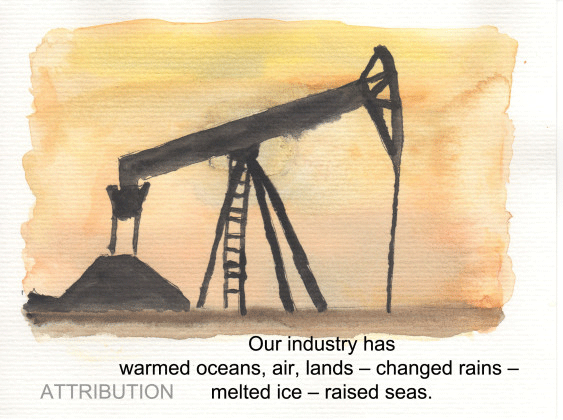
Attribution Haiku (Photo: Gregory Johnson)
JOHNSON: That’s right.
CURWOOD: So remind us of the rules of haiku.
JOHNSON: So the rules in English are different from the rules in Japanese, but the strict rules are a syllable count of 5-7-5 in the three lines. They’re supposed to be a reference for the season, and the Japanese have specific words for these I think. And these don’t necessarily have references to seasons in them, but they do have references to change in climate, and I thought they’d give me a pass on that. And they’re also supposed to have what the Japanese call a cutting word, sort of a transition. Not all of these do have that actually, but they do all follow the 5-7-5 rule.
CURWOOD: Now, will you read two more for us that are closely related? They are called Response and Attribution.
JOHNSON: Yes, the first one is response.
We burn more carbon
Air warms for decades but seas
For millennia
And then Attribution:
Our industry has
warmed oceans, air, lands, changed rains
melted ice, raised seas..

Future, Reprise Haiku (Photo: Gregory Johnson)
CURWOOD: Incredible how so few words can be so powerful. What got you going with haiku?
JOHNSON: I post almost exclusively in haiku on Facebook. I find that it helps me be in the present. It tends to link my posts a little more closely to nature and what’s going on around me. And it also limits the number of posts, which my friends probably like.
CURWOOD: All of your poems are accompanied by a water color painting. The last one about industry goes along with a painting of an oilrig. There’s another with a painting of windmills on a rolling hill. Will you read that please?
JOHNSON: Let’s see.
Fast, strong action will
Reduce future warming but
Rising seas certain
CURWOOD: So, Greg, what kind of responses have you gotten so far from this project?
JOHNSON: They’ve really been quite positive. I have to say, actually, it took some time, on my part, to get up the courage to put this out there. This, of course, is a distillation of, as you said, work of 209 lead authors, 50 review editors, 1,000 expert reviewers, so a huge amount of work went into this. But the response to the haikus have been remarkably positive.
CURWOOD: What kind of response have you gotten from your IPCC co-authors?
JOHNSON: They enjoy it. I did make a number of little booklets on my own dime, and have given them to friends and colleagues and authors, and it’s been a positive response from them as well.
CURWOOD: Have you run out of the booklets?
JOHNSON: Pretty much. Yes.
CURWOOD: What’s your publisher say?
JOHNSON: I don’t have a publisher. These were are self-published. I can’t actually profit from these in any way because they’re related to my work, and that’s just one of the rules of my employer.
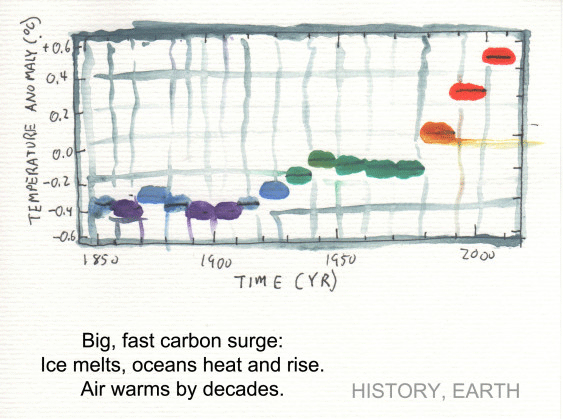
History, Earth Haiku (Photo: Gregory Johnson)
CURWOOD: Well, we are just about out of time, Greg, but I wonder if you will read one final haiku for us. Perhaps the one that you titled ‘future?’
JOHNSON: Alright.
Forty years from now
Children will live in a world
Shaped by our choices.
CURWOOD: Greg, you have children?
JOHNSON: I have a daughter.
CURWOOD: Who’s how old?
JOHNSON: She’s 17 now.
CURWOOD: When she’s 57...
JOHNSON: ...the world will be a very different place, I think, and it will depend on what choices we make. We’re living in a world now that’s already shaped by our choices.
CURWOOD: Greg Johnson is a NOAA oceanographer and lead author of the Working Group I report chapter on oceans. Thanks so much for taking the time with us today.
JOHNSON: Thank you.
Related links:
- Daily Sightline
- The IPCC Summary For Policy Makers Physical Science Assessment
[MUSIC: Kris Bowers Vices & Virtues from Heroes & Misfits (Concord Music 2014)]
CURWOOD: Next time on Living on Earth, new evidence that pesticides can affect the children of farmworkers.
FREINKEL: When they were seven, the kids who had had the greatest pre-natal exposure tested lower on IQ tests - they had a seven point on average lower score.
CURWOOD: Those lower IQ scores and other impacts can add up to high costs for society. That's next time on Living on Earth.
CURWOOD: Living on Earth is produced by the World Media Foundation. Naomi Arenberg, Clairissa Baker, Bobby Bascomb, Emmett Fitzgerald, Helen Palmer, Catalina Pire-Schmidt, Adelaide Chen, James Curwood and Jennifer Marquis all help to make our show. Jeff Turton is our technical director. Alison Lirish Dean composed our themes. You can find us anytime at LOE.org, and like us on our Facebook page - it’s PRI’s Living on Earth. And we tweet from @LivingOnEarth. I'm Steve Curwood. Thanks for listening.
ANNOUNCER 1: Funding for Living on Earth comes from the Grantham Foundation for the protection of the environment, supporting strategic communications and collaboration in solving the world’s most pressing environmental problems. The Kendeda Fund, furthering the values that contribute to a healthy planet, and Gilman Ordway for coverage of conservation and environmental change. Living on Earth is also supported by a friend of The Nation, where you can read such environmental writers as Wen Stephenson, Bill McKibben, Mark Hertsgaard and others at TheNation.com. This is PRI, Public Radio International.
ANNOUNCER 2: PRI, Public Radio International.
Living on Earth wants to hear from you!
Living on Earth
62 Calef Highway, Suite 212
Lee, NH 03861
Telephone: 617-287-4121
E-mail: comments@loe.org
Newsletter [Click here]
Donate to Living on Earth!
Living on Earth is an independent media program and relies entirely on contributions from listeners and institutions supporting public service. Please donate now to preserve an independent environmental voice.
NewsletterLiving on Earth offers a weekly delivery of the show's rundown to your mailbox. Sign up for our newsletter today!
 Sailors For The Sea: Be the change you want to sea.
Sailors For The Sea: Be the change you want to sea.
 The Grantham Foundation for the Protection of the Environment: Committed to protecting and improving the health of the global environment.
The Grantham Foundation for the Protection of the Environment: Committed to protecting and improving the health of the global environment.
 Contribute to Living on Earth and receive, as our gift to you, an archival print of one of Mark Seth Lender's extraordinary wildlife photographs. Follow the link to see Mark's current collection of photographs.
Contribute to Living on Earth and receive, as our gift to you, an archival print of one of Mark Seth Lender's extraordinary wildlife photographs. Follow the link to see Mark's current collection of photographs.
 Buy a signed copy of Mark Seth Lender's book Smeagull the Seagull & support Living on Earth
Buy a signed copy of Mark Seth Lender's book Smeagull the Seagull & support Living on Earth

